Who says wolves only kill the weak? If a hunter had done this there would be a price to pay.
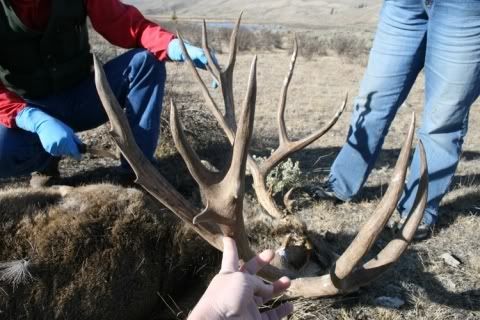
Who says wolves only kill the weak? If a hunter had done this there would be a price to pay.

I have wondered why there are lots of acorns some years, and none other years. Acorns are reportedly important to mule deer in building fat reserves for winter. I have also wondered why some years the muley bucks grow very good antlers and other years, they don’t.
My observation for this year is that there are almost no acorns, at least in northern Arizona and southern Utah, and that it is a good horn-growing year.
I believe I know why there are no acorns. We had an early, warm spring – followed by a late hard frost. Since then, we have had a wet fall. I believe this weather pattern is also responsible for the good antlers we have been seeing. It has been quite a few years since I have seen so many big, heavy antlered bucks in general.
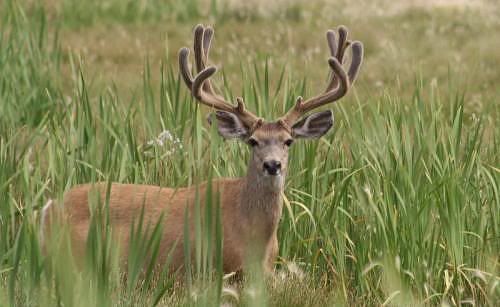
So, I will say to you rifle hunters: Don’t shoot the first buck you see. There are not a lot of bucks, but there are some good ones.
The bucks are also in very good shape already in spite of a lack of acorns.
 Not long ago, a subscriber to the, now defunct, Utah DWR forum made the comment that the DWR could not manage a herd of chickens. I wondered if they could manage a herd of sheep. Managing sheep isn’t all that different from managing mule deer ( I have seen both some pretty wild sheep and some pretty tame mule deer ). Deer and sheep have quite a bit in common. They eat about the same stuff. They stress out when encountering unfamiliar humans and predators. They have about the same number of young over about the same life span. One male can cover about the same number of females. And, so on.
Not long ago, a subscriber to the, now defunct, Utah DWR forum made the comment that the DWR could not manage a herd of chickens. I wondered if they could manage a herd of sheep. Managing sheep isn’t all that different from managing mule deer ( I have seen both some pretty wild sheep and some pretty tame mule deer ). Deer and sheep have quite a bit in common. They eat about the same stuff. They stress out when encountering unfamiliar humans and predators. They have about the same number of young over about the same life span. One male can cover about the same number of females. And, so on.
I don’t know which is easier – managing a herd of sheep or a herd of chickens. Chickens are pretty stupid. But, what I do know is that there are folks who have successfully managed both for quite a few years. So what is the matter with our wildlife agencies? Could they manage a herd of anything? For one thing, most of them don’t view it as part of their job to manage a herd of anything. For another, they have such a educational bias, that they can’t see the forest for the trees.
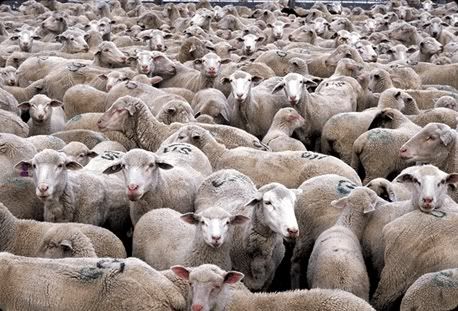 If you and I had a herd of sheep, and our joint livlihoods depended on the management of that herd, and we turned our herd over to one of the state agencies – wouldn’t we go belly up? Why is that? The agencies are unwilling ( once upon a time they may have been willing ) to do what it takes to manage a herd. If a herd can manage itself, then fine, but the agencies will not manage a herd. Their management of wild chickens (grouse/quail), is as good an example of poor herd management as is their management of mule deer.
If you and I had a herd of sheep, and our joint livlihoods depended on the management of that herd, and we turned our herd over to one of the state agencies – wouldn’t we go belly up? Why is that? The agencies are unwilling ( once upon a time they may have been willing ) to do what it takes to manage a herd. If a herd can manage itself, then fine, but the agencies will not manage a herd. Their management of wild chickens (grouse/quail), is as good an example of poor herd management as is their management of mule deer.
If we employed a good sheep herder to manage our herd of sheep, we would have a hard time convincing him that allowing the sheep to be killed by predators would have no impact on the herd. Yet, that is exactly what the agencies believe. The agencies have the crazy notion that if the lions and coyotes don’t kill the deer something else will, and therefore, the lions and coyotes are having no impact.
The owner of a herd of sheep “saves” his surplus sheep for slaugter and for human consumption. He is unwilling to give them to predators. He realizes that sheep are capable of producing an annual surplus and he wants to use that surplus profitably. A concept known as maximum sustainable yield, is a fundamental principle once studied and used by wildlife biologists. Basically, this concept is to maximize your surplus while maintaining your base. Our agencies have strayed about as far from this principle as they can get, but they are still trying to get farther from it than they already are. They are moving steadily toward zero yield.
Abandonment of the principle of “maximum sustainable yield” is a primary reason why modern wildlife agencies cannot ( or will not ) manage a herd of sheep, deer, or chickens. Throw in the lack of interest or motivation, and you’ve got what you’ve got.
At about 9:00am on the morning of August 1, 2008, I was in the yard watering trees when I heard a howl that sounded much like a wolf. It was soon followed by several answers that were definitely coyotes. Almost every day, I hear coyotes howling, so I don’t usually perk up that much at the sound. But this day the sound was a little different and seemed to be within 2-300 yards.
I ran into the house, grabbed camera, gun, and binoculars and headed for the truck. I drove past the neighbors, parked the truck and headed after the coyotes. Right in the neigbors front yard I noticed a doe acting a little peculiar. I was in a hurry to find those coyotes, so I didn’t give the doe much thought.
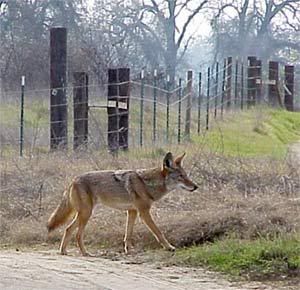 After a good hike, and having found no sign of coyotes – I returned to the truck. When I went past, the doe was still standing in the same spot. If it is possible for a doe to be forlorned and depressed, that is exactly how she looked. She did not move. I suspected she had just had fawns. And then realized why the coyotes had been there so close to the houses. I filmed her and then looked around for fawns. Examining the doe closely, it very much appeared as if she had just had fawns, but I could not find them. Talking with another neighbor, the next day, I learned that the coyotes had killed the fawns.
After a good hike, and having found no sign of coyotes – I returned to the truck. When I went past, the doe was still standing in the same spot. If it is possible for a doe to be forlorned and depressed, that is exactly how she looked. She did not move. I suspected she had just had fawns. And then realized why the coyotes had been there so close to the houses. I filmed her and then looked around for fawns. Examining the doe closely, it very much appeared as if she had just had fawns, but I could not find them. Talking with another neighbor, the next day, I learned that the coyotes had killed the fawns.
Last year, my other neighbor had a very similar episode right in his yard. It seems that the deer, and quite a number of other animals, as well, have decided that it is safer by the houses than out with the predators. This time it didn’t work. The coyotes are getting more brazen. They come in the yard frequently. Both of our cats have succombed to coyotes. One was taken right off the back porch.
I do what I can to save the little game we have from being eaten by coyotes, but sometimes my efforts are not enough.
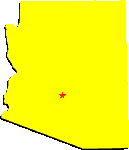
Here in Northern Arizona, we have a rainy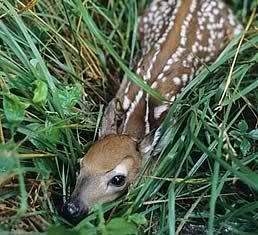 season referred to by locals as the Monsoon Season. This year and last, it began about the first week of July and lasted until the end of July. Just coincidentally, this is the time when most of the fawns are born. In other areas, fawn mule deer may be expected to be born about the first week of June. I have seen several does this week, that look like they are about ready to pop, but still haven’t shed that excess weight.
season referred to by locals as the Monsoon Season. This year and last, it began about the first week of July and lasted until the end of July. Just coincidentally, this is the time when most of the fawns are born. In other areas, fawn mule deer may be expected to be born about the first week of June. I have seen several does this week, that look like they are about ready to pop, but still haven’t shed that excess weight.
When I moved to Arizona, I expected that fawns would be born much earlier – even April. This assumption was based on the, apparently, false logic that the further south you go, the earlier spring arrives. The earlier the spring, the earlier the fawning season. Now the question that might be on your mind is – wouldn’t the breeding season have to be later?
In order for fawning to occur in late July, breeding must occur in late December – early January. Because winter doesn’t get serious until that time period, mule deer don’t have much cause to congregate. Breeding doesn’t occur until bucks and does get together. During the summer and even into late fall, mule deer in this part of the world are spread as thin as the hair on top of my head.
That’s my twist on when fawns are born and why. Pay attention and see what you observe.

FLAGSTAFF, Ariz. — While mountain lion hunting in Colorado can be quite good, if the idea of hiking for miles through knee-deep snow doesn’t appeal to you, consider a trek across the border and south, into Arizona, for a horseback ride into cougar country.
The Arizona Game & Fish Department estimates the state’s mountain lion population at around 2,500. Lions are present throughout the entire state, with the exception of the very southwest corner.
The most popular game management unit for lions is the famous 12A south unit, in the Kaibab National Forest north of Flagstaff.
Other lion-heavy areas include units 22, 23, 24A (north and east of Phoenix), and units 27, 28 and 31 east and north of Tucson, which includes the Blue Wilderness Area.
Good go-to advice
According to a current research project being conducted by AZGFD, the lion’s primary habitat in the state appears to be principally in timbered areas, particularly in units populated by stands of chaparral and ponderosa pine.
Mountain lions tend to follow the deer herds to some extent, but will also hunt other game animals including elk.
Due to the drought Arizona has faced over the past years, the mule deer population is down, whitetail deer populations have remained stable, and javelina populations are down. But at 2,500 lions, the lion population in Arizona is relatively healthy.
When to hunt
With the exception of special units closed to hunting, and units closed during certain times of the year (be sure to consult the 2005-2006 Arizona Hunting Regulations brochure), lion season is open year-round. But lions are generally hunted in the winter months (October through April) due to the moisture that helps the dogs pick up scent, and because of milder temperatures for hunters (and dogs).
Of special interest to lion hunters is Arizona’s regulation allowing a hunter to harvest a lion a day in certain game management units, until the harvest objective has been met.
After that, the limit reverts back to one lion per year (and none of the previous lions harvested count against the one per year limit).
The reason for this allowance is that AZGFD is attempting to protect transplanted bighorn sheep in certain GMUs.
Hunters can call (877) 438-0447 for up-to-date info on open units.
License info
Nonresidents may purchase a mountain lion tag over-the-counter (called a “non-permit” tag) for $200, in addition to needing a nonresident hunting license.
Hunters must contact AZGFD within 20 days of harvest, and must provide a sample tooth of any harvested lions.
Go guided
If you hire a guide, be sure to ask if his dogs are “dry land” lion dogs. These specially trained dogs are more adept lion trackers than the “damps,” or wet ground dogs.
The going rate for a lion hunt is around $3,500, with hunts usually organized into 4-day or 8-day ventures.
Contact information
Arizona Game & Fish Department (602-942-3000)
Pat Barber, predator and furbearer biologist (602-789-3354)Guides and outfitters
Outdoorsman’s (602-944-7121)
Bedlion Outfitters (928-526-5993)
Arizona Lion Hunts (623-386-0102)
Arizona Wildlife Outfitters (928-681-4867)
By Jim Smith
Fishing and Hunting News
February 15, 2006,
Folks in Northern Utah are fed up with having no mule deer. Meanwhile, the growing elk herd is getting fed up with hay.

A local family, in Cache Valley, has been using personal resources as well as donated hay to feed a growing herd of elk for 20 plus years now. The local deer lovers have been planting bitterbrush for deer to eat and now the elk have to go.
The Utah DWR is willing to reduce elk numbers to a minimum which may include shipping some to nearby Hardware Ranch where elk are fed every winter. Not everyone is happy about this. The sad thing is, fewer elk and more bitterbrush will not necessarily mean more deer. The mule deer in that area have had 25 years to recover but can’t do so because they are being eaten as fast as they can reproduce.
Nonetheless, this is a precedent setting action. This is the first time I have heard of an agency “voluntarily” reducing elk numbers in order to help mule deer. I wonder what position they will take if it doesn’t help. Stay tuned.
This project was started in 2002 and should be completed by now, although I haven’t yet seen any results published. Chances are the outcome was pre-determined. This is another project that is a colossal waste of time and money. I, personally, do not need a study to know that an animal, any animal, humans included, are effected by what they eat, or don’t eat. But, I also don’t need a study to know that once a doe has been eaten by a lion or a coyote, she won’t be having any more fawns.
If habitat is an issue, the time and money would be far better spent by just going out and improving habitat. Habitat is killing far less mule deer than predators. If WSU really wanted to help the deer – as opposed to just spending research dollars, they should just go kill some predators. I think the truth is – they want to blame anything but the predators for the “20 year decline in mule deer”.
——————————————–
Mule deer research includes ultrasonography, WSU nutrition study with captive herd
Posted August 2002
By W. L. Myers, Jr., Wildlife Biologist
WDFW Wildlife Program
WDFW’s five-year research project to learn more about mule deer populations in northeast and north-central Washington is now in its second year with expanded activities underway. The project includes body condition scoring using ultrasonography for comparison with a captive deer herd diet and nutrition study at Washington State University (WSU). The study area, where to date 184 mule deer does have been captured and equipped with radio telemetry or satellite GIS (Geographical Information System) collars, covers all or parts of Chelan, Okanogan, Ferry, Stevens, Lincoln, Adams, Whitman, and Pend Oreille counties. In many of these areas, mule deer populations have been declining, as evidenced by survey results and hunter harvest.
One factor in those declines may be low nutrition forage. Doe deer with diet deficiencies could have later-than-optimal pregnancies, produce fawns with low birth weights, abort fetuses, have stillborns, or not even conceive. Poor nutrition is reflected in deer body condition and fat levels. Those conditions are being measured through ultrasonography (the same ultra-sound technology used in human health care) in the collared does when they are re-captured twice a year – once going onto winter range and again as deer leave the range at the end of winter. This body condition information from wild deer in the study area will be compared to body condition data collected from the captive herd at WSU to determine if diet deficiencies are part of the problem. The WSU deer diet study involves 40 female mule deer fawns. Some of the fawns were collected in spring 2002 from state licensed wildlife rehabilitators who receive them as orphans or pick-ups. Many were captured from the wild in an area of Whitman County where mule deer have been causing agricultural crop damage and hunting permits have been increased to reduce their numbers. The fawns will be held in captivity for the rest of their lives, so they are purposely being habituated to their human handlers for ease of operation as the study proceeds.
Once the fawns are weaned from their bottle-fed milk formula, group feeding trials will begin. Some groups will receive high nutritional diets, others low. Their body condition will be measured periodically using the same ultrasonography as in the wild deer re-capture portion of the research. They will be bred by captive bucks and their reproductive success or failure tracked.
By comparing the body condition measures between the captive deer on controlled diets and the wild deer, WDFW researchers hope to gain information that may connect the physical condition and fawn production of individual deer with on-the-ground habitat conditions. Vegetative mapping and evaluation of nutritional values of forage species work began in the spring of 2002. The results may indicate needs to improve, enhance or protect mule deer habitat in some areas, or simply change harvest management to reduce mortality on herds that are less than stable.
Other possible factors in mule deer declines are also being explored in this multi-faceted research project. The collared deer are monitored weekly to track movements, determine habitat preferences, calculate population densities, measure herd boundaries and home range sizes, and learn rates, patterns, and causes of death. Surveys are also being conducted to measure deer numbers, age and sex composition. The information is needed to learn more about population regulatory mechanisms and landscape-level habitat relationships.
Some of the data collected is being used to evaluate the effectiveness of the traditional “density-dependent” model of mule deer harvest management. Harvest rates are dependent on the density of the deer population, which is dependent on available habitat. The density dependent management model assumes that hunting harvest does not add to overall deer mortality, but that as hunting harvest increases, natural mortality decreases. This model was developed from white-tailed deer population studies and may not be appropriate for managing mule deer. With a better understanding of mule deer population dynamics, WDFW should be able to more carefully manage Washington’s mule deer through hunting restrictions and habitat protection.
More mule deer does will be equipped for monitoring as the study continues. That process starts with capturing the animals using a helicopter net-gunning crew that slings the netted deer to a site for processing by WDFW and volunteer crews. The deer are weighed and measured, and blood and fecal samples are collected for laboratory assessments of disease exposure, trace element levels, DNA and parasite loads. They are examined manually and through ultrasonography to determine body condition, pregnancy, and fetus size and number. The deer are equipped with radio telemetry or GIS collars. Prior to release, the deer receive shots of long-acting penicillin and a selenium-vitamin E compound to help mitigate the stresses of capture and handling.
Starting in the winter of 2002-03, a number of six-month-old mule deer fawns in each site will also be radio tagged to assess survival and dispersal.
Researchers from WSU’s Large Carnivore Laboratory are also investigating the relationships between mule deer, white-tailed deer, and mountain lions as part of this project.
Deer monitoring is conducted by graduate students from the University of Washington, Washington State University, Central Washington University, and University of Idaho. Volunteers from the Inland Northwest Wildlife Council and Asotin County Sportsmen Association are also helping capture and monitor the deer.
This project is truly an inter-agency one and would not be possible without the support and involvement of many cooperating entities, including the Bonneville Power Administration, Colville Confederated Tribes, Spokane Tribe, Kalispel Tribe, Chelan County Public Utility District, U.S. Forest Service’s Colville and Okanogan National Forests, the Bureau of Land Management, Washington Department of Transportation, Washington Department of Natural Resources, Northwest Okanogan Sports Council, Inland Empire Chapter of the Safari Club International, and the Mule Deer Foundation.
———————
PULLMAN, Wash. — Is poor nutrition contributing to a decrease in the number of mule deer in the Pacific Northwest? That is a question researchers at Washington State University are working to answer using deer hand-raised on the Pullman campus.
Lisa Shipley, associate professor in natural resources and a scientist in the WSU Agricultural Research Center, is part of a team led by wildlife biologist Woody Myers of the Washington Department of Fish and Wildlife working to determine why the number of mule deer in the state has steadily declined over the past 20 years. She says the captive herd makes it easier to determine exactly what’s going on in the wild.
“There are too many variables in the field,” she said. “The importance of captive animals is that you can isolate and remove different variables to determine exactly how nutrition affects reproduction.”
Shipley, along with graduate student Troy Tollefson, have hand-raised approximately 30 mule deer does, two bucks and numerous fawns, so they are able to work with the animals more easily. They feed each doe one of three diets high, medium or low nutrition based on fiber and protein content.
“We try to mimic the conditions in the field as closely as possible,” said Shipley. “Some years in some locations, there is plenty of water and lots of yummy vegetation for the deer to eat. In other years drought years there isn’t as much.”
The research team carefully monitors the differences in the does. They measure body weight and devised a way to measure body fat as well. They take milk samples and study nursing patterns. They also keep track of the size and growth of the fawns.
While still in the process of analyzing the data gathered over the past three years, Shipley says nutrition does appear to play a pivotal role in the number of fawns born.
“It looks like we’ve got fewer twins among the does on the lowest nutrition diet,” she said. “And the thinnest does haven’t given birth yet, and may not at all. Although, it also appears that even at about 5 percent body fat they can still reproduce.”

If you applied for a 2008 Nevada Mule Deer hunt, and want to see if you drew,
Click 2008 NEVADA DRAW RESULTS
“If God didn’t want us to eat MULE DEER, He wouldn’t have made them out of meat”
——————————————
“You’ll often read that venison contains a lower level of cholesterol than beef, but this just isn’t true. This article, excerpted from my book, “Making the Most of Your Deer” (2000), contains USDA data, cut-for-cut.”
——————————————
EXCERPT FROM “MAKING THE MOST OF YOUR DEER” BY DENNIS WALRODfrom Chapter 6: “The Cholesterol Wars”
Nutritional Value of VenisonVenison, when properly prepared, is a culinary delight that holds its own in the company of fine wines and other condiments. The meat has a fine-grained, interesting texture, yet is tender without being mushy as are some of the more expensive cuts of domestic meats. But the good news doesn’t end here. Not only is venison delicious, it also is better for your nutritional well-being than are most commercially available meats. In this day and age when so many tasty items have been found to be either worthless or even potentially harmful to your health, rest assured that venison compares favorably with the supermarket alternatives. Venison is low in fat and calories and is high in minerals and vitamins. It also is free from chemical additives, synthetic growth hormones and other nasty substances.
Some of venison’s nutritional superiority exists solely by the default of our modern meat raising systems. Still, the basic fact remains that whitetail deer are highly efficient processors of the natural foods they eat. The buds, herbs, acorns, wild fruits, and other browse in a deer’s diet are effectively converted into muscle, and the benefits of this natural food fare are passed along to those of us who enjoy venison. It’s truly an “organically grown” product!
…….it’s obvious that venison ranks very high by modern dietary standards. For one thing, venison fat content, and consequently the caloric count, is relatively low. Even when all excess fat has been trimmed from a beefsteak or pork cut, there still remains a high level of fatty tissue entwined within the muscle fibers (we call it “well-marbled”) of domestic red meat. When a portion of venison is trimmed of fat, the remaining meat is 97.8 percent fat-free. Now that’s what you can properly call lean meat! Venison also contains comparably high levels of calcium, magnesium, phosphorous, and iron. These minerals are essential to our well-being, and it’s great that we can partake of them while enjoying a gourmet venison meal. And let’s not forget the vitamins; venison scores high in thiamine, riboflavin, niacin, plus Vitamins B6, B12, and E. In fact, it has been calculated that a one-pound venison steak contains more than the full recommended daily adult allowances for thiamine and niacin and a major share of the recommended riboflavin allowance. These are natural vitamins, products of nature rather than of industry, and they come to you indirectly in venison from the foods of the forest.
Cholesterol in Venison? – the Real Story, Right Here
Everyone knows that the cholesterol level in venison is lower than in beef and pork…right? Wrong! I wish that I could claim that cholesterol in venison was low, right along with the established benefits of higher vitamins and minerals and lower fat content, but that just wouldn’t be true. It turns out that, yes, although certain parts of a deer (such as the round steak) are slightly lower in cholesterol than some other parts of beef and pork, the total edible venison from a deer contains a slightly higher average cholesterol than do beef or pork. To get an accurate comparison, you need to look at the same cuts of meat from a beef cow or pig as you do for a deer, because they’re all different! Don’t just take my word for it, go to the USDA National Nutrient Database at:
http://www.nal.usda.gov
and see for yourself. This remarkable Website lists the nutritional values for virtually all of the more common meat cuts from most domestic animals and some game animals, and further provides good nutritional data for cooked versus uncooked meats, and fat-trimmed versus cooked as-is. The cholesterol content of any animal is tied more directly to the lean meat than to the fat content of the animal. You might be surprised to learn that fat contains very little cholesterol! So it’s a see-saw…calories from fat, or cholesterol from the lean meat. Pick your poison…but please add the right spices first!
_____________________________________________________ Gourmet Food on a Survivor’s Budget
Good food is somewhat expensive, sure, but the cost of true gourmet food is out of sight. Just to have the experience of grilling a prime beefsteak in the backyard, the average person might have to scrimp on other groceries. We would like to be able to experiment with different sauces and exotic recipes, but with meat prices so high we restrict our culinary adventures to within the affordable and commonplace. Instead we often limit our skills to the preparation of tossed salads and hamburger dressings. Why take a chance with big money, right?
Well, with a supply of venison stocked away in the freezer, we can experiment to our heart’s content. Make no mistake about it, venison qualifies as a gourmet delicacy in every sense of the word. Venison has a distinctive flavor, responds well to special cooking techniques, is uniquely different from domestic meats, and last but not least, is difficult to obtain. Venison has the status of exclusiveness because wild venison cannot be legally sold or purchased. (The venison that sometimes appears on some restaurant menus originates from licensed deer farms. These pastured deer are fed commercial foods and consequently, the taste of their venison is somewhat different.)
Restaurants charge exorbitant prices for such exotics as truffles, caviar, morels, lobster, escargots, and other choice items that are obtained chiefly not from domestic sources but from the natural world.
But then, so would venison be expensive; that is, if you could buy it. If you had to pick up the tab for someone else’s hunting trip every time you had a venison meal, you would soon come to understand the real meaning of the words “exclusive” and “expensive.” The fact that we hunt for pleasure, rather than for food or profit, does not alter the fact that venison has all the qualifications of a gourmet food. A lot has been written about how venison can be made to taste just like beef so that those people who profess not to like wild game would not be able to tell the difference. That certainly is true; with a little cover-up here and there, venison can be made to pass for beef. But why would you want to do a thing like that? Why try to alter a gourmet food into something ordinary?
Venison should be appreciated for its own merits, much the same way that you relish a lobster for its sweet, succulent flavor. Sure, you could prepare a lobster in ways that would disguise the piquant odor of the ocean, and pass it off as farm-raised. Similarly, venison should not automatically be dummied up with strongly flavored sauces solely to change the taste of it into something that could be mistaken for a domestic meat. Take the approach of the gourmet and limit the use of sauces to only those which will enhance the natural taste and flavor of venison. A fine wine, good music in the background, candles (optional), the children either young and in bed, or grown and off someplace (also optional), and a fine meal of venison with the proper accompaniments–what else could you possibly ask in the way of a gourmet meal of fine cuisine?
The Tragedy of Modern Domestic Meats
Sometimes you can get as many chuckles from reading the advertising hype on a package of processed supermarket meat as you can from the comic section of the weekend newspapers. Seems that meat is inevitably packaged under brand names that are designed to evoke images of sunshine, shade trees, sparkling brooks and so on, scenes where children soar kites under perpetually blue skies and Mom is in the kitchen forever baking apple pies. This advertising often contains a picture, typically one that shows a smiling, straw-hatted farmer feeding only two or three head of livestock. Even the livestock are smiling (although somewhat ironically). You get the mental picture, standing there in the supermarket, that the contents of the package you are holding were grown back in the Good Old Days and then were mysteriously transported into the Here and Now, just for you. You even feel strangely reassured that those little piggies (or whatever) in the picture received many affectionate pats on the rump during their rich and full lives down on the farm.